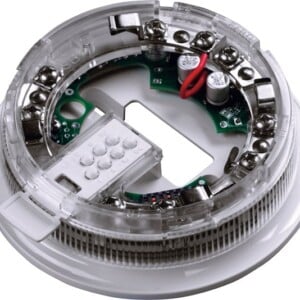Description
58000-500APO – Apollo Discovery Ionisation Smoke Detector
The Discovery Ionisation SmokeDetector uses a low activity radioactive foil to detect fires by irradiating the air in the smoke chambers and causing a current flow. If smoke enters the chamber, the current flow is reduced leading to an alarm.
Operation
The Discovery Ionisation Detector uses the same outer case as the optical smoke detector and is distinguished by the red indicator LEDs. Inside the case is a printed circuit board which has the ionisation chamber mounted on one side and the signal processing and communications electronics on the other. The ionisation chamber consists of a reference chamber contained inside a smoke chamber.The outer smoke chamber has inlet apertures fitted with insect resistant mesh. At the junction between reference and smoke chambers, the sensing electrode converts variations in chamber current into voltage changes. When smoke particles enter the ionisation chamber, ions become attached to them with the result that the current flowing through the chamber decreases. This effect is greater in the smoke chamber than in the reference chamber, and the imbalance causes the sensing electrode to become more positive. The analogue voltage at the sensor electrode is converted to a digital format which is processed to provide an analogue value for transmission to the fire control panel when the device is polled.
Key Features
- Responds well to fast-burning, flaming fires
- Designed to operate in a variety of environments
- Resilient to dust
- Five response modes
- Remote test feature






Reviews
There are no reviews yet.